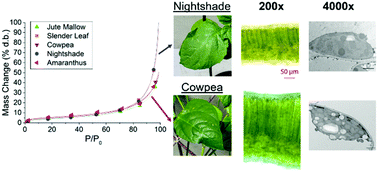当前位置:
X-MOL 学术
›
Food Funct.
›
论文详情
Our official English website, www.x-mol.net, welcomes your
feedback! (Note: you will need to create a separate account there.)
Drying of African leafy vegetables for their effective preservation: the difference in moisture sorption isotherms explained by their microstructure.
Food & Function ( IF 5.1 ) Pub Date : 2020-01-20 , DOI: 10.1039/c9fo01175g Leonie van 't Hag 1 , Jessica Danthe , Stephan Handschin , Gibson P Mutuli , Duncan Mbuge , Raffaele Mezzenga
Food & Function ( IF 5.1 ) Pub Date : 2020-01-20 , DOI: 10.1039/c9fo01175g Leonie van 't Hag 1 , Jessica Danthe , Stephan Handschin , Gibson P Mutuli , Duncan Mbuge , Raffaele Mezzenga
Affiliation

|
The problem of malnutrition and nutrition deficiency, as well as droughts that lead to reduction in food supply and starvation, is well documented for Sub-Saharan Africa. Reducing post-harvest losses of five species of African leafy vegetables (ALVs) by preservation through drying is studied herein. Energy efficient gentle drying conditions using superabsorbent polymers and a temperature of 40 °C were shown to preserve most leaf structures and vitamins. The microbial safe moisture content of the ALVs was found to be ≤14% dry basis. Dried Slender Leaf and Nightshade leaves could be rehydrated to the equilibrium moisture content of fresh leaves upon dry storage, while it was not possible for Jute Mallow, Cowpea and Amaranthus. This was attributed to different palisade parenchyma cell lengths. An increased amount of starch granules as observed in the microstructure of Cowpea and Nightshade leaves is suggested to explain their fibrous texture upon cooking. These results show that the ALVs can be effectively preserved using the same drying method and that this can be used to fight micro-nutrient deficiencies during droughts.
中文翻译:

干燥非洲多叶蔬菜以有效保存:其微观结构解释了水分吸收等温线的差异。
撒哈拉以南非洲地区有充分的营养不良和营养不足问题,以及导致粮食供应和饥饿减少的干旱问题。本文研究了通过干燥保存来减少五种非洲多叶蔬菜(ALV)的收获后损失。使用高吸收性聚合物的节能高效温和干燥条件和40°C的温度可保持大多数叶片结构和维生素。发现ALV的微生物安全水分含量以干基计≤14%。干燥储存后,可以将干燥的细长叶片和茄属植物叶片补水至新鲜叶片的平衡水分含量,而黄麻锦葵,Cow豆和A菜则不可能。这归因于不同的栅栏实质细胞长度。建议在of豆和茄属植物叶片的微观结构中观察到淀粉颗粒数量的增加,以解释其在烹饪时的纤维质地。这些结果表明,使用相同的干燥方法可以有效地保存ALV,并且可以将其用于应对干旱期间的微量营养素缺乏症。
更新日期:2020-02-13
中文翻译:

干燥非洲多叶蔬菜以有效保存:其微观结构解释了水分吸收等温线的差异。
撒哈拉以南非洲地区有充分的营养不良和营养不足问题,以及导致粮食供应和饥饿减少的干旱问题。本文研究了通过干燥保存来减少五种非洲多叶蔬菜(ALV)的收获后损失。使用高吸收性聚合物的节能高效温和干燥条件和40°C的温度可保持大多数叶片结构和维生素。发现ALV的微生物安全水分含量以干基计≤14%。干燥储存后,可以将干燥的细长叶片和茄属植物叶片补水至新鲜叶片的平衡水分含量,而黄麻锦葵,Cow豆和A菜则不可能。这归因于不同的栅栏实质细胞长度。建议在of豆和茄属植物叶片的微观结构中观察到淀粉颗粒数量的增加,以解释其在烹饪时的纤维质地。这些结果表明,使用相同的干燥方法可以有效地保存ALV,并且可以将其用于应对干旱期间的微量营养素缺乏症。











































 京公网安备 11010802027423号
京公网安备 11010802027423号